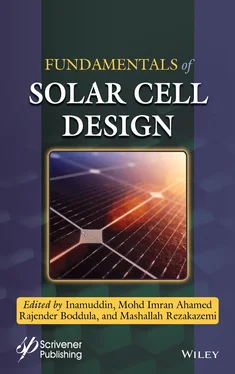4 Chapter 4 Figure 4.1 Schematic of a state-of-art p-i-n a-Si:H solar cell on a glass supers... Figure 4.2 Series connection of a-Si:H solar cells on a TCO-coated glass superst... Figure 4.3 Schematic cross section of a ceramic thin film CdTe solar cell [2].Figure 4.4 Cross section of the CdS/CdTe solar cell [2].Figure 4.5 The structure of CIGS solar cell [2].
5 Chapter 5Figure 5.1 Fabrication of multilayered bio-hybrid solar cells. Reprinted from Re...Figure 5.2 Schematic of a general biohydrid solar cell. Reprinted with pemission...Figure 5.3 Schematic presentation of the poly(mercapto-p-benzoquinone)/photosyst...Figure 5.4 Electrochemical synthesis of PANI-PSI solid films . Reprinted with pem...Figure 5.5 Potential energy diagram demonstrating the energy alignment of the PA...Figure 5.6 The structure of the fabricated device. Reprinted with pemision of Re...
6 Chapter 6Figure 6.1 DSSC working mechanism [7].Figure 6.2 Preparation of simple DSSC in lab scale at room temperature.Figure 6.3 Gold nanoparticles incorporated at outer surface of photoanode [9].Figure 6.4 Various counter electrodes used in DSSCs.Figure 6.5 Various electrolytes used in DSSCs.Figure 6.6 Classification of anthocyanins.
7 Chapter 7Figure 7.1 Classification of solar cells.Figure 7.2 Configuration of a DSSC. Here, the S°, S*, and S +denote, respectivel...Figure 7.3 Calculated HOMO and LUMO states for (a) an isolated system and (b) a ...Figure 7.4 The diagram of energy for C 60-por-XP complex (X = metal) (a) X = Fe, ...
8 Chapter 8Figure 8.1 Diagram of overall solar radiation [1].Figure 8.2 Global net radiation [2].Figure 8.3 Turkey’s insolation map.Figure 8.4 Ankara solar radiation map.Figure 8.5 On horizontal superficies, annual sun irradiation values’ variation o...Figure 8.6 Solar radiation on horizontal superficies.Figure 8.7 For 24-hour period, annual direct momentary irradiation values on inc...Figure 8.8 Yearly diffuse momentary irradiation values for inclined superficies.Figure 8.9 Yearly total momentary irradiation values for inclined superficies.Figure 8.10 Momentary total irradiation for yearly angle and hours.Figure 8.11 The weights according to AHP approach.Figure 8.12 Scores according to resulting priorities.
9 Chapter 9Figure 9.1 Scheme for light-scattering effect in dye-sensitized solar cells.Figure 9.2 Schematic representation of reflection losses occurring in a solar ce...
10 Chapter 10Figure 10.1 A general diagram of a SC displaying different layers responsible fo...Figure 10.2 (a) Solar cell, (b) solar module, and (c) solar panel.Figure 10.3 J-V curve of a SC showing J sc, V oc, and FF.Figure 10.4 Prominent inorganic, organic, and hybrid SC materials.Figure 10.5 (a) A monocrystalline Si lattice and (b) mono c-Si SC, (c) a polycry...Figure 10.6 A general structure of a c-Si SC.Figure 10.7 A general structure of a Si thin-film SC.Figure 10.8 A general structure of a single-junction GaAs SC.Figure 10.9 A general structure of a CIGS SC.Figure 10.10 A general structure of a CdTe SC.Figure 10.11 (a) A few examples of commercially available donor materials (small...Figure 10.12 A few examples of commercially available acceptor materials for OSC...Figure 10.13 A general structure of (a) multi-layer OSC and (b) BHJ OSC.Figure 10.14 A general structure of a DSSC.Figure 10.15 Structures of organic dyes and electrolytes used in DSSC.Figure 10.16 A general structure of PSC.
11 Chapter 11Figure 11.1 Transient kinetics of a P3HT:CdS device for various weight compositi...Figure 11.2 Transient absorption spectra of P3HT films with different crystallin...Figure 11.3 Transient absorption data for the neat materials in the studied blen...Figure 11.4 Reconstructed volume of the micropillar after electron tomography, s...Figure 11.5 The schematic of the C-AFM analysis setup. Reproduced with permissio...Figure 11.6 Topography images of (a) pristine and (b) treated PEDOT:PSS films; C...Figure 11.7 (a) Work function of TiO 2and α-Fe 2O 3semiconductor before heterojun...Figure 11.8 Electronic energy levels of the sample and AFM tip for three cases: ...Figure 11.9 The whole surface potential distribution along the cross-section. In...Figure 11.10 (a) Schematic of photo-KPFM experiment on MAPbI3/CTM bilayers. Surf...Figure 11.11 TEM image of perovskite solar cell with device structure of glass/I...
12 Chapter 12Figure 12.1 Exponential decrease in cost of solar power ($/Watt) over the years ...Figure 12.2 Principle of operation of a p-n junction solar cell. Radiation is ab...Figure 12.3 Photo-generated carriers in a solar cell due to absorption of light....Figure 12.4 Finger electrodes on a p-n junction solar cell. The design consists ...Figure 12.5 Schematic of the basic structure of a silicon solar cell [56].Figure 12.6 (a) Schematic illustration of the inverted CuSCN-based perovskite so...Figure 12.7 Schematic of the DSSCs with a sandwich TiO 2thin-film electrode [79]...Figure 12.8 (a) IPCE and (b) current density-voltage (J-V) curves measured under...Figure 12.9 Chemical structures of polymers P1 and P2 [89].Figure 12.10 Currently, polymer solar cells are far behind the conventional sili...Figure 12.11 Schematic representation of QDSCs [93].Figure 12.12 Schematic of operating principle and energy band diagram of QDSCs [...Figure 12.13 Schematic of the mechanism of an organic solar cell [56].
13 Chapter 13Figure 13.1 Comparison of effect of different annealing temperature on MAPbI 3an...Figure 13.2 (a) Regular PCS performance under visible light (LED). (b) Regular P...Figure 13.3 (a) MSSC PCS performance under standard luminance (A.M. 1.5 G and 1,...Figure 13.4 Titled octahedral with slightly curves path for migration of ion [56...Figure 13.5 (a) Comparison of PCE decreasing rate (12h) of two structural assemb...Figure 13.6 Comparison of Change in PCE of ZnO nanoparticle–based PSC and FTZO n...Figure 13.7 (a) Stability test of CH 3NH 3PbI 2Br/P3HT PSC in ambient environment...Figure 13.8 (a) SEM image of spheroidal graphite-based PSC. (b) SEM image of fla...
14 Chapter 14Figure 14.1 Schema of a PV cell in a PV panel.Figure 14.2 Schema of a PV system [13].Figure 14.3 PV module structure [9, 21].Figure 14.4 PV production capacity in Giga Watt (GW) ([24]; source: https://en.w...Figure 14.5 PV reduction cost in Giga Watt (GW) for scenario 1, scenario 3, and ...Figure 14.6 Blocking diodes (black diodes) at parallel modules [21].Figure 14.7 CdSe nanowire arrays synthesized by electrodeposition. (a) Top-view ...Figure 14.8 Evolution of C/Si heterojunctions [67].Figure 14.9 Schema of energy band (EB) of the C/Si heterojunctions: (a) p-n junc...Figure 14.10 Schema of a NFA-BOHJ PV cell: (a) configuration and (b) EB alignmen...Figure 14.11 Degradation of perovskites with (A) heat, (B) light, (C) oxygen, an...Figure 14.12 Schema of the A-cations as well as their substitutions in perovskit...Figure 14.13 Schema of the X-anions as well as their substitutions in perovskite...Figure 14.14 Two structures of metal-halide–based perovskites [138].Figure 14.15 Schematic of the structures: (a) p-n structure and (b) n-p-n struct...Figure 14.16 Processing sequence of the honeycomb substrate [146].Figure 14.17 Schema of the building with TSFM as integrated substrates [147, 148...Figure 14.18 Solar tracking system structure based on angle and light; Wa is the...Figure 14.19 Solar tracking system model [3].Figure 14.20 Output evaluating and motor control diagram [13].Figure 14.21 Schema of solar tracking system [3].Figure 14.22 Schema of solar cell receivers; Center point defined by lenses a, b...Figure 14.23 Schema of an AUOS vehicle [156, 157].Figure 14.24 Roof-top design patterns [158].Figure 14.25 Schema of the GCPVS [1, 213].Figure 14.26 Schema of the SAPVS [1].Figure 14.27 Schema of single crystalline Si solar cell [2].Figure 14.28 Microwave heating of the wafers for doping introduction in the mate...Figure 14.29 Schema of VAM [175].Figure 14.30 Schema of the refrigerator PV system; PCM is Pulse-Code Modulation ...Figure 14.31 Tubular receiver made of (a) a stainless steel tube (b) with depth ...Figure 14.32 The key elements of a solar drying system [176].Figure 14.33 Schema of the water network with solar PV system.Figure 14.34 Solar PV system diagram with Energy Storage Subsystem (ESS) [182].Figure 14.35 Schematic of the AC smart grid/hybrid-PV system. PMSG is the Perman...Figure 14.36 Voltage and frequency control by PV and pitch angle of the WTG by a...Figure 14.37 PI controller for WTG pitch angle [3].Figure 14.38 Schema of the MPPT controller [13].Figure 14.39 Schema of an EPN [204].Figure 14.40 Schema of data centers [204].Figure 14.41 Perovskite PV cell evolution [206].Figure 14.42 Proposed power generation system [115].
Читать дальше












